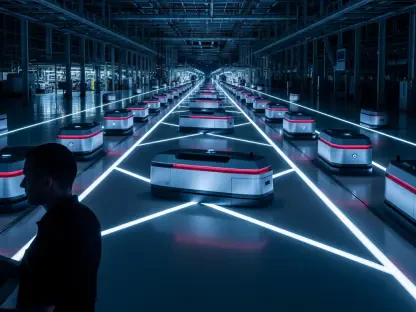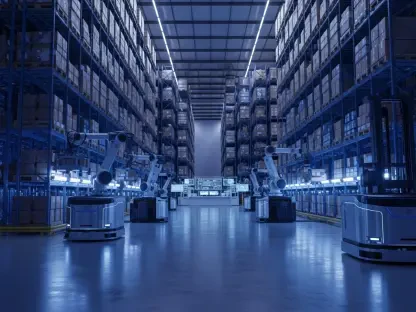In today’s hyper-connected digital landscape, data centers serve as the critical infrastructure supporting everything from cloud computing to artificial intelligence applications, handling an unprecedented volume of information that powers global economies. The complexity of managing these facilities has skyrocketed with the rise of hyperscale setups and the relentless demand for uptime, making traditional manual processes not just inefficient but often unfeasible. Robotics has emerged as a transformative force in this arena, promising to redefine operational efficiency, slash costs, and bolster reliability in ways previously unimaginable. By automating repetitive tasks, enhancing security, and enabling sustainable practices, robotic technologies are addressing the pressing challenges faced by data center operators. This article delves into the profound impact of robotics on data center management, exploring how innovations like AI integration and collaborative systems are shaping the industry. From the push toward fully autonomous “lights-out” facilities to the diverse applications across sectors, the narrative of robotics in this space is one of strategic necessity and rapid evolution.
Addressing the Demand for Efficiency
The scale and intricacy of modern data centers, particularly hyperscale and colocation facilities, have rendered manual oversight increasingly impractical. With the need for continuous operation and the processing of massive data volumes, even minor human errors can lead to significant downtime, a risk that operators simply cannot afford. Robotics offers a compelling solution by taking over routine yet critical tasks such as server monitoring, hardware installation, and cable management. These automated systems execute with precision, drastically reducing the likelihood of mistakes and ensuring seamless functionality in high-density environments. Beyond error reduction, robotic intervention minimizes operational interruptions, allowing data centers to maintain the uptime that is so vital to their clients. This shift to automation is not merely a trend but a fundamental response to the growing complexity of digital infrastructure, where efficiency is paramount.
Furthermore, the adoption of robotics addresses labor shortages that plague the industry, especially as data centers expand globally. Automated systems can operate around the clock without the fatigue or limitations associated with human staff, ensuring consistent performance. This capability is particularly valuable in environments where tasks are repetitive and physically demanding, freeing up skilled personnel to focus on strategic decision-making and innovation. The financial benefits are also significant, as robotics can lower long-term operational costs by reducing the need for extensive human intervention. As data centers grapple with ever-increasing workloads driven by technologies like IoT and AI, the integration of robotics becomes a cornerstone for scalability and reliability, setting a new standard for operational excellence in the sector.
Harnessing AI for Smarter Automation
One of the most groundbreaking advancements in data center robotics is the integration of artificial intelligence, which elevates automation from mere mechanization to intelligent operation. AI-powered robots can autonomously navigate complex facility layouts, identify operational anomalies in real time, and even predict hardware failures before they disrupt services. This predictive maintenance capability transforms data centers into proactive environments, where potential issues are addressed preemptively, minimizing downtime and optimizing resource use. From robotic arms that swiftly replace malfunctioning servers to software-driven automation handling data backups, AI is the brain behind the brawn, enabling a level of precision and foresight that manual processes cannot match.
Additionally, the synergy between AI and robotics extends to workload management, a critical aspect of data center efficiency. Intelligent systems can dynamically balance computational loads, ensuring optimal performance while reducing energy waste. This adaptability is crucial in environments where demand fluctuates rapidly, such as during peak usage periods for streaming or e-commerce platforms. Moreover, AI-driven robotics can learn from operational patterns, continuously improving their effectiveness over time. This learning capability means that data centers are not just reacting to current needs but are evolving to anticipate future challenges. As the digital landscape becomes more intricate, the role of AI in robotic systems is proving indispensable, driving a shift toward smarter, more resilient data center operations that can keep pace with technological advancements.
Scaling Operations in Hyperscale Environments
The emergence of hyperscale data centers, designed to support the colossal needs of global tech giants, has intensified the demand for scalable automation solutions. These massive facilities manage workloads that would overwhelm traditional human-led operations, processing data at a scale that requires relentless efficiency. Robotics provides the answer by automating tasks across vast server arrays, from hardware maintenance to inventory tracking, ensuring that operations run smoothly without proportional increases in labor costs. This scalability is a game-changer, allowing hyperscale centers to expand capacity rapidly while maintaining service quality, a necessity in an era where digital demand shows no signs of slowing.
Beyond mere scalability, robotics is paving the way for “lights-out” data centers—facilities that operate entirely without on-site human presence. Such autonomous setups rely on robotic systems to handle everything from routine maintenance to emergency responses, reducing operational risks associated with human intervention. This trend is particularly significant for hyperscale operators who prioritize consistency and cost-effectiveness across global networks. The ability to manage these sprawling facilities remotely, supported by robotic automation, also aligns with modern business models that favor minimal physical staffing. As hyperscale data centers continue to dominate the industry, robotics stands as a critical enabler, ensuring that scale does not compromise efficiency or reliability in meeting the world’s insatiable data needs.
Bolstering Security and Sustainability
Robotics in data centers extends far beyond operational efficiency, playing a pivotal role in enhancing physical security and advancing environmental goals. Automated drones and robotic patrols are increasingly deployed for real-time surveillance, capable of detecting unauthorized access or potential threats with speed and accuracy that surpass human capabilities. These systems provide continuous monitoring across sprawling facilities, ensuring that security breaches are identified and addressed instantly. This heightened level of protection is essential in an industry where data integrity and facility safety are paramount, safeguarding sensitive information against both physical and operational risks.
Equally important is the contribution of robotics to sustainability, a pressing concern amid growing regulatory demands and corporate responsibility targets. Robotic systems assist in thermal mapping and energy optimization, identifying inefficiencies in cooling and power usage that can significantly reduce a data center’s carbon footprint. By automating adjustments to environmental controls, these technologies ensure that energy consumption aligns with actual needs, cutting waste without compromising performance. This focus on green operations not only helps data centers meet compliance standards but also lowers operational costs over time. As environmental scrutiny intensifies, the role of robotics in promoting sustainable practices becomes a key differentiator, aligning technological progress with ecological responsibility in the digital infrastructure space.
Democratizing Access with Innovative Models
The financial barrier to adopting robotics in data centers is being dismantled through innovative approaches like Robotics-as-a-Service (RaaS). This model allows operators, particularly smaller enterprises, to leverage cutting-edge automation without the burden of significant upfront investments. By subscribing to robotic solutions on a service basis, data centers can access the latest technologies while maintaining budgetary flexibility, a crucial advantage for businesses scaling their digital operations. RaaS is democratizing automation, ensuring that the benefits of robotics—such as enhanced efficiency and reduced human error—are not limited to large-scale players but are within reach of a broader range of organizations.
Moreover, the rise of RaaS aligns with regulatory trends that prioritize workplace safety and data security. By automating hazardous or repetitive tasks, robotic systems minimize human exposure to risky environments, such as high-voltage areas or confined server spaces. This not only improves safety outcomes but also reduces liability for operators. Additionally, the service-based model often includes ongoing support and updates, ensuring that robotic systems remain secure against evolving cyber threats. As the industry moves toward greater inclusivity in technology adoption, RaaS and similar models are proving instrumental in leveling the playing field, allowing diverse data center operators to harness automation for operational excellence and resilience.
Embracing Collaborative and Remote Solutions
A notable trend in data center robotics is the rise of collaborative robots, commonly known as cobots, which are designed to work alongside human staff to enhance productivity. Unlike fully autonomous systems, cobots focus on augmenting human capabilities, assisting with tasks that require precision or strength while ensuring safety in shared workspaces. This collaboration is particularly valuable in environments where human oversight remains essential, such as during complex system upgrades or troubleshooting. By integrating cobots, data centers can strike a balance between automation and human expertise, optimizing workflows without displacing skilled personnel.
Parallel to this is the growing emphasis on remote operability, a shift that gained momentum following global health challenges and the need for reduced on-site staffing. Robotics enables comprehensive monitoring and maintenance from afar, with systems capable of executing tasks based on remote commands or pre-programmed protocols. This ensures operational continuity even in scenarios where physical access to facilities is limited, maintaining service reliability without compromising safety. Remote robotic solutions also facilitate global management of multiple data centers, allowing operators to oversee disparate locations from a centralized hub. As remote work models become entrenched in the industry, robotics is proving to be a linchpin in sustaining efficiency and adaptability across varied operational landscapes.
Navigating Global Market Dynamics
The data center robotics market is experiencing robust growth worldwide, with distinct regional dynamics shaping its trajectory. The United States holds a commanding position, driven by technological leadership and the presence of major industry players who are early adopters of automation. Meanwhile, China is emerging as a powerhouse with rapid expansion fueled by aggressive investments in digital infrastructure, reflecting a national priority to dominate the tech landscape. These contrasting drivers highlight how global demand for robotics is influenced by local economic and strategic priorities, creating a diverse yet interconnected market.
Europe, on the other hand, is carving its niche by emphasizing sustainability in robotic adoption, aligning with stringent environmental regulations and a strong focus on energy efficiency. Other regions, such as Asia-Pacific and Canada, are also showing steady progress, adapting robotics to meet specific infrastructural needs and regulatory frameworks. This global variation underscores the adaptability of robotic solutions, which can be tailored to address unique challenges, whether it’s scale in the U.S., speed in China, or sustainability in Europe. As the market continues to expand, these regional differences illustrate the universal appeal of robotics in modernizing data center operations, ensuring that automation remains relevant across diverse geopolitical and economic contexts.
Adapting to Diverse Sector Needs
Robotics in data centers is not a monolithic solution but a versatile technology with applications spanning multiple components and industries. Hardware solutions, such as mobile robotic units and automated arms, cater to physical tasks like server maintenance, while software-driven robotics handle AI-powered operations like workload balancing. Services, including consulting and integration, further support tailored implementation across sectors like IT, finance, and healthcare. This wide applicability ensures that robotics meets the specific demands of varied operational environments, from high-security financial data centers to latency-sensitive healthcare systems.
The diversity extends to enterprise size as well, with solutions scalable for both large corporations and small-to-medium businesses. Large enterprises often deploy comprehensive robotic systems to manage extensive infrastructures, while smaller operators leverage modular or service-based automation to address niche needs without overextending resources. This adaptability highlights the transformative potential of robotics, ensuring its relevance regardless of organizational scale or sector focus. As data centers across industries face unique pressures—be it regulatory compliance in banking or uptime demands in streaming—robotics provides customized tools to enhance performance, demonstrating its critical role in the broader digital ecosystem.
Overcoming Barriers and Envisioning Growth
Looking back, the journey of robotics in data center operations reveals significant strides in addressing operational complexities, with adoption accelerating as challenges like labor shortages and uptime demands intensified. The technology tackled inefficiencies head-on, automating mundane tasks and enabling predictive maintenance through AI integration, which proved instrumental in preventing disruptions. Despite initial hurdles, such as high costs for smaller enterprises, innovative models like Robotics-as-a-Service emerged as vital solutions, broadening access to automation. Security and sustainability also saw remarkable improvements, as robotic systems enhanced threat detection and energy optimization in response to regulatory and corporate pressures.
Reflecting on this progress, the path forward involves prioritizing cybersecurity enhancements to protect increasingly autonomous systems from vulnerabilities. Industry stakeholders should focus on developing robust frameworks for integrating IoT and robotics, ensuring seamless scalability as data demands grow. Additionally, fostering partnerships between technology providers and data center operators can accelerate innovation, tailoring solutions to regional and sector-specific needs. As the landscape evolves, investing in training programs to bridge expertise gaps for smaller firms becomes a clear next step, ensuring equitable benefits from robotic advancements. These actionable strategies promise to sustain the momentum, positioning robotics as a cornerstone for smarter, more resilient data center management in the years ahead.









